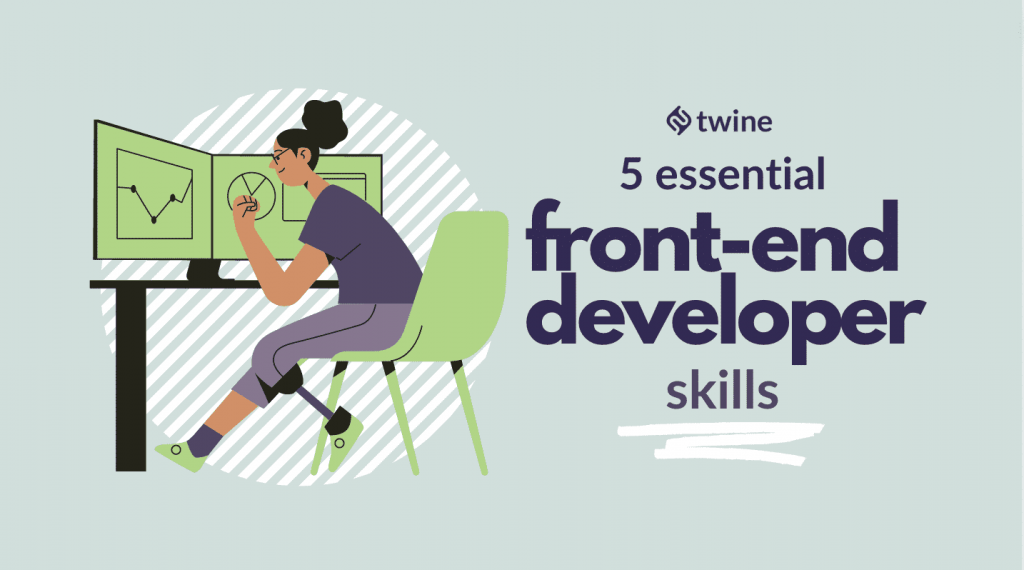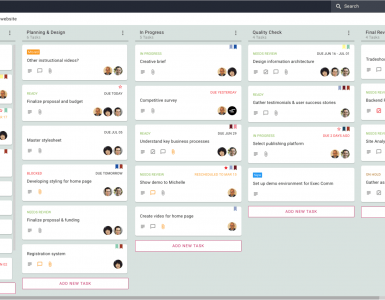
For more Web Tools, check out the Freelancer Toolkit…
The past few years have prompted a lot of changes around the world. The IT industry was at the forefront of those changes – since businesses and people moved online. According to research, the average internet user spends almost seven hours online daily. But what about a front-end developer?
Well, the increased internet use has encouraged companies to invest in their websites and apps.
This is where front-end development comes into play. A front-end developer’s mission is to improve the look and feel of a site or app.
Today, we’ll discuss the five essential front-end developer skills you need to stand out in this profession.
Let’s start with the basics…
Want to join a community of talented, front-end developers? Click here to get started.
What is a Front-End Developer?
A front-end developer has developed everything you see and interact with while using a site or app.
Front-end developers leverage web technologies like HTML and CSS to create websites and applications. From the buttons and fonts to the general layout, a front-end developer creates the overall look of a product.
A front-end developer’s job is to improve the user experience as well. They want to make a website or app accessible across multiple platforms, devices and browsers. It is paramount nowadays because 88% of customers wouldn’t visit a website twice if it delivers a bad user experience.
Front-End vs Back-End
The IT industry is rapidly evolving. It has become difficult to track new technologies and developments. That’s why some people might confuse front-end with back-end development. As we’ll explain below, the two are not the same.
Front-end and back-end developers deal with different aspects of a website or app.
Front-end development is the process of building and coding the visual elements of a product. It focuses on what a user will see and interact with.
On the other hand, back-end development concentrates on a product’s aspect a user cannot see, i.e., the server side. It builds a product’s structure from scratch and creates its overall functionality. Back-end developers use server-side programming languages like Python and Java to develop websites and apps.
That is the main difference between front-end and back-end development. Now that we’ve explained that, let’s delve deeper into a front-end developer’s tasks.
The Responsibilities of a Front-End Developer
If you want a career in front-end development, you must know which tasks await you. As a front-end developer, you will:
- Optimize all elements to improve the user experience
- Build tools to ensure a website works on any browser
- Determine the structure and look of web pages
- Ensure a product is mobile-friendly
- Implement a search engine optimization (SEO) strategy
- Perform regular testing to ensure speed and scalability
The tasks may differ depending on the client and end product. However, you should expect the tasks mentioned above in most cases.
5 Must-Have Skills…
You don’t need a college degree to become a front-end developer. You can complete an online course provided it helps you develop the below essential front-end developer skills:
- HTML and CSS
- JavaScript
- jQuery
- Frameworks and libraries
- Responsive design
We’ll go over each skill now.
HTML and CSS
Two programming languages are the core of front-end development—HTML and CSS. You cannot build any websites if you don’t master them.
The HyperText Markup Language (HTML) sets the framework of your product. It defines the structure of every web page you develop. You use it to create a code version of your website. Although launched almost 30 years ago, HTML is still the go-to web technology for front-end developers.
HTML can’t work without the Cascading Style Sheets (CSS).
CSS is a programming language that enables you to bring the document you develop with HTML to life. A front-end developer uses CSS to create a website’s design, colors, fonts and layout. CSS gives your product its visual appearance.
If you’re serious about becoming a front-end developer, you must learn both CSS and HTML. The one won’t work without the other.
JavaScript
Another essential programming language is JavaScript (JS). It helps you take your website or app to the next level.
JavaScript allows you to add more functionality to your product. It is your go-to tool when you want to include interactive features such as polls and forms. You can also use it for dynamic elements like video, audio, animations and online games.
JS is one of the most important tools nowadays. According to research, 69% of developers use it regularly. HTML and CSS are in second place in the survey.
jQuery
Closely connected with JavaScript is jQuery. It is a JS library that consists of plugins and extensions. Having access to this collection makes the process of working with JavaScript faster.
You can use pre-built components and personalize them to to fit your needs better. It gives you access to many JavaScript functions without the need to do the coding yourself.
For instance, you can use features like:
- CSS manipulation
- HTML/DOM manipulation
- Animations
- Events
- Effects
It simplifies the above processes, helping you code and develop faster. In fact, almost almost 80% of all websites use jQuery. This has made it an almost integral part of web development.
Frameworks and libraries
Another front-end developer skill you should acquire is using existing frameworks and libraries.
A framework is a pre-made structure that is a foundation for developing websites and apps. It speeds up development as you aren’t starting from scratch. You’re using a template that you can modify and customize.
Front-end developers usually leverage JavaScript and CSS frameworks. Examples include Ember, AngularJS and Bootstrap. Some of these frameworks are perfect when you want to develop complex user interfaces or change how the content is displayed.
Libraries are also helpful. They are a collection of extensions you can leverage to improve your website. Most developers use them to add pre-made elements to a web page. For instance, they access libraries to add countdown timers on an e-commerce website.
Frameworks and libraries ensure you don’t ever have to start from scratch.
Responsive design
Technology has advanced so much that we are no longer tied to only one device. Internet users now visit websites using computers, smartphones or tablets. Front-end developers must keep this in mind and learn more about responsive design.
Responsive web design focuses on developing websites that load the same on all devices. It ensures that a web page automatically adjusts depending on the screen size. It improves the user experience.
As a front-end developer, you should use HTML and CSS to enlarge or resize a website automatically. When a user switches from their computer to a smartphone, your website should also switch to ensure every image, animation, video or content appears the same.
Conclusion
The IT industry continues to thrive. Now is the perfect time to become a front-end developer and take advantage of the booming industry. However, if you want to excel, you should develop the skills we mentioned in our article.
The five essential front-end developer skills will help you code and develop websites or apps that leave a lasting impression on internet users. Start learning them now!
Ready to get hired? At Twine, we have dozens of top-quality jobs being posted each and every day. From design to marketing, development to copywriting – there’s a job ready for your skills. Join the marketplace of diverse creative talent here.








